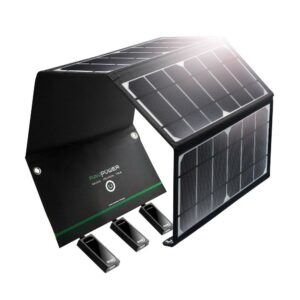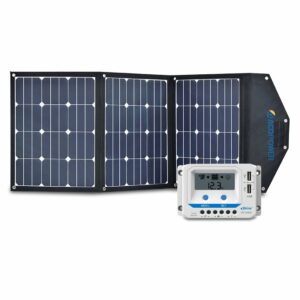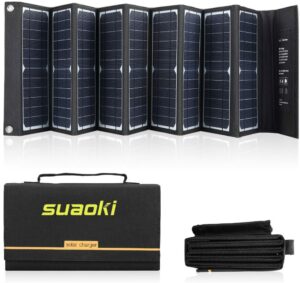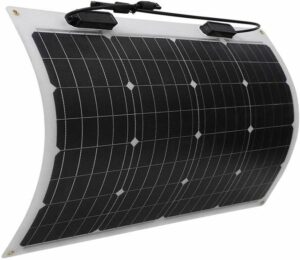- 1. Solar panels for camping
- 2. Solar Panels for Motorhomes
- 3. Solar Panels For Campers
- 4. Solar Panels on Camper Vans
- 5. How Do Solar Panels Work on Caravans?
- 6. Are Caravan Solar Panels Any Good?
- 7. What Are The Best Solar Panels For Caravans?
- 8. Which Solar Panels Are Best For Camping?
- 9. Are Solar Panels For an RV Worth It?
- 10. How Much Power Does a 100-watt Solar Panel Produce In a Day?
Some people like to bond with nature when they go camping/hiking. Others hate to go off the grid. When going camping, not being able to keep food cool or to recharge a phone is a significant problem for some.
Portable solar panels offer a superb solution to that conundrum. They enhance comfort in ways that some people will find extremely useful. Camping/hiking purists, on the other hand, may frown at such “unnecessary luxury”.
In some cases, however, portable solar panels make perfect sense for everyone. If you decide to live on a boat for the summer, for instance, you will need electricity. Portable solar panels will cover those needs, giving you plentiful, free and green electricity.
This article covers the various uses of solar panels, as well as technicalities concerning setup and exploitation. It also takes a look at the best available solutions.
Solar panels for camping
When it comes to portable solar panels, you have to assess your needs carefully. There are scores of options in this regard. You can use roof-mounted solar panels, which are quite similar to residential solar panels. Of course, they are lighter and produce less electricity.
Thin-film solar panels and rollup solar blankets are also available.
What does your solar panel camping kit comprise?
– The solar panel can be one of three types. The most “basic” and the most efficient, is the crystalline silicon panel. Such panels come in monocrystalline and polycrystalline variants. The monocrystalline version is more efficient at converting sunlight into electricity. Polycrystalline panels are cheaper, however. Because they are less efficient, you will need more polycrystalline panels to generate the same amount of electricity.
Thin-film and amorphous silicon panels are also cheaper. They too are less efficient, however, than the monocrystalline panels. The advantage of thin-film panels is that they are foldable. Thus, they take up less space during transportation.
The efficiency of solar panels increases as the temperature drops. Thus, in the summer, the efficiency of solar panel camping kits drops. Thin-film solar panels are slightly less susceptible to losing efficiency at higher temperatures.
– Motorhome and caravan solar panels charge batteries. Campers/hikers then use the battery to power lights and various appliances around the motorhome/tent. Some people use 12v solutions, taking an extra car battery with them to provide electricity when needed.
Acquiring a dedicated battery is a better choice, however. According to greenmatch.co.uk, deep cycle batteries are the most useful. Such batteries allow for deep discharge and charge cycles, without losing efficiency. You should be aware however that leaving less than 20% charge in your battery may damage it.
– If you intend to use more than just a dim DC light, you will also need an inverter. Much like with residential PV solutions, inverters turn DC electricity from the panels into AC. You can then use AC to power your appliances.
Long story short, the components of a caravan/motorhome/boat PV system are the same as those of a residential solution. Size restrictions mean less power though and cheaper prices. Your solar panel camping kit will also include electrical leads (cables) and a charge controller.
Solar Panels for Motorhomes
Motorhomes offer the most comfortable camping conditions. They are usually large vehicles which means they offer ample space for solar panels as well. The first step when it comes to choosing a PV solution for your motorhome is to assess your energy consumption.
Charge up your battery and go out camping for a few days. See how long it lasts for you. Do not use your appliances more than you normally would. At the end of that test, you will have to make some calculations.
Power is measured in watts. Energy is measured in watt-hours. The capacity of your battery is measured in amp-hours. What this means is that power is current times voltage. Energy is power times the number of hours. The capacity of your battery is the energy it provides divided by the voltage.
If you have a 100 Ah battery and it lasts you a day, that 100 Ah is what you need your PV system to deliver per day. In this case, a day does not equal 24 hours. Only count the daylight hours.
So how does Ah relate to Wh? Based on the above explanation: Ah (the capacity of your battery) = Wh (the energy)/ V (Voltage). From here, Wh = Ah*V.
For the 100Ah example, this means that your Wh=100*12 (assuming a 12v battery). Therefore, your Wh = 1,200. This is a LOT, but this is nothing more than a theoretical example. Your Wh needs are likely much lower.
You can also calculate your energy needs by taking the individual power rating of every appliance in your motorhome and dividing it by 12 (the voltage). Then you add up the lot and you have the capacity requirement you have to cover.
So how much energy can various motorhome PV systems churn out?
According to lifesure.co.uk this is the lowdown in this regard:
| PV Panel Power Rating | Daily Power Output in Summer | Daily Power Output in Winter |
| 4W | 28Wh | 3Wh |
| 10W | 70Wh | 8Wh |
| 20W | 140Wh | 16Wh |
| 25W | 175Wh | 20Wh |
| 50W | 350Wh | 40Wh |
| 80W | 560Wh | 65Wh |
| 100W | 700Wh | 80Wh |
| 150W | 1050Wh | 120Wh |
Note that these values are valid for the UK and they are not exact. They are ballpark approximations, meant to serve as mere guidelines. They can, however, help you with picking the right motorhome solar panel system.
In addition to the capacity of the PV system, you need to consider the following:
- Will your chosen system fit your motorhome?
- Is your battery in top shape?
- Can you place the panels in direct sunlight at all times?
- Is your motorhome under warranty? If it is, adding the solar panels may void the warranty.
- Replacing your bulbs with LED ones makes a LOT of sense.
- Keep your panels clean, to have them delivering their rated output.
Solar Panels For Campers
Since campers are smaller versions of motorhomes, it is safe to say that the same principles apply to them when choosing a PV solution. Go through the mentioned steps to determine your energy consumption/need. Once you know what you need, you can go shopping.
Bear in mind that just throwing money at the undertaking is far from optimal. If you pay too much for your PV system, you risk never being able to recoup your investment. Here is a brief list of possible PV system choices for your motorhome, camper or caravan.
We are looking at two bulkier/bigger and two lighter/more portable systems.
– According to caravanguide.co.uk the Truma SolarSet 100W system is a top option. It costs GBP 648. What do you get for that kind of money?
The SolarSet is a complete solar system and it includes:
- Aluminum mounting system for the roof.
- Roof lead-through.
- Heavy-duty cables.
- Cables for battery connection.
- Screws.
- Regulator.
- Automatic charger.
- Cleaning fluid.
- Sealant.
The system weighs 8.8 kg, and its panel construction is monocrystalline. The dimensions of the panels are 1,263mm X 535mm X 70mm.
Although the manufacturer does not provide details in this regard, we can assume that at 100Wp, the voltage delivered is in the 12-15V range, while the amps are in the 6.5-8A range.
– The NDS 120W Aero is a solid PV panel, that comes with an aluminum frame and mounting bars. Users can fix the system to their motorhomes and campers via screws or adhesives.
Given its solid nature, this solution is not a lightweight one. It tips the scale at 10.5kg. The maximum power output of the Aero is 120W. It is available in lower wattages as well. The size of the Aero is 1,475mm X 541mm X 60mm. Its features include:
- A special, tempered glass protection of the monocrystalline cells.
- A total of 40 cells.
- 5m of cable.
- Mounting brackets.
Costing GBP 270, this one is a bit of a budget solution.
– Unlike the SolarSet, the NDS 110W SolarFLEX is a lightweight solution. It is thus perfect for campervans and other smaller vehicles. As its name lets on, the SolarFLEX is a semi-flexible PV panel system. Nonetheless, it offers monocrystalline efficiency.
The panel comes with 5m of twin cable and it costs GBP 339. For that money, it delivers 17.7V and 6.04 amps at peak power.
Its features include:
- Back contact technology – the semi-flexible solar panels come with an adhesive back.
- Sunpower cells.
- Holes for screws.
- A weight of just 3.23kg.
- Dimensions of 1070mm X 540mm X 3mm.
– The Ventura Portable Power SPV280 strays from the vehicle-fitted mold. This one is a fully portable PV system, focused on lower-wattage mobile device charging.
The system comprises eight panels that fold out. The construction of the solar cells is monocrystalline. The efficiency rating of the system is 21 percent.
The SPV280 comes with 11 charging adaptors. You can use it to charge phones, tablets, laptops, and cameras.
At a weight of just 1.45kg, it is an interesting addition to your camping gear. The size of this PV system is 131mm X 50mm X 37mm. Its output voltage is 5/9V – 18V.
Solar Panels on Camper Vans
Camper vans run a wide range of sizes. Bigger and more solid PV systems suit larger campers. Smaller vehicle owners should focus on smaller, more lightweight solutions. The above-mentioned solutions cover most needs in this regard.
How Do Solar Panels Work on Caravans?
Solar panels on caravans work the same way they do on residential roofs and motorhomes. They generate free and emissions-free electricity.
On a caravan, solar panels may fulfill two roles. On the one hand, they can keep charge in the battery of the caravan/motorhome, when used off the grid. This is the primary purpose of caravan solar panels.
On the other hand, they help keep the battery alive while the caravan is not in use. In the UK, such periods of passive storage are quite long for caravans. Trickle-charging batteries with whatever electricity solar panels can generate in the winter will help keep those batteries in shape.
The lead-acid batteries used for cars, motorcycles and caravans do not react well to losing charge completely. Prolonged lack of charge leads to the formation of lead sulfate crystals on the lead dioxide plates of the battery.
According to outandaboutlive.co.uk A battery will “leak” around four percent of its charge while unused, per week. This makes it clear that over four months, the battery can sustain permanent damage.
Are Caravan Solar Panels Any Good?
Caravan solar panels are most definitely great, within certain limits, of course. If you choose the right PV system for your vehicle, you will enjoy the luxury of free electricity while camping.
The maintenance of caravan solar panels is just as simple as that of a residential system. Just make sure your panels are clean and that they are not shaded.
What Are The Best Solar Panels For Caravans?
– According to productspy.co.uk, the best PV system for caravans is the 12V Monocrystalline Solar Panel by SunGoldPower. This system comes with a 25-year warranty on the solid panel.
With the panel, you also get a charge controller with an LCD as well as MC4 cables. Aluminum brackets and screws are included.
The cost of this solar system is GBP 120.
– The Portable Poly Folding Solar Power Kit only costs GBP 100. The panels fold up in a highly portable suitcase form. This 100W system comes with a solar charge controller, offering overcharge protection. The Portable Poly is very durable. That said, you can fold it up and stash it away for the winter.
The only problem with this system is that it does not come with a clear set of instructions.
– RAVPower’s 24W Solar Panel with Triple USB Ports is lighter, more portable and cheaper than any of the options we have thus far listed.

Costing only GBP 60, this solar panel offers an efficiency of up to 23.5 percent. Featuring a durable fabric base, it comes with a pocket to accommodate your mobile devices.
Its iSmart charging technology automatically detects the charged device. It thus delivers the optimum charge.
Which Solar Panels Are Best For Camping?
Camping solar panels have to be lighter and more portable than their vehicle-mounted counterparts.
– The ACOPOWER 120W Portable Camping Solar Panel is a great option. This fabric-based, folding solar system comes with a charge controller. It features a 25 percent efficiency. The stands in the back of the panel holder allow for ideal positioning. At $352, this system is one of the more expensive ones.

– The SUAOKI 60W Camping Solar Panel also folds up in a handy suitcase. Under good sunlight, the system provides enough power to charge two mobile devices simultaneously. The efficiency of this solar panel system is 20 percent. A special 10-in-1 connector offers connectivity with any laptop. The cost of the SUAOKI 60W is around $190, according to Amazon.

– The Renogy 50W Flexible Camping Solar Panel can be bent into a 248-degree arc. This durable and flexible solar panel system is suitable for use on RVs and boats as well. For just $80, this system features outstanding efficiency, due to its transparent dots technology. It tips the scale at just 2.87 lbs. It is only a tenth of an inch thick.

Are Solar Panels For an RV Worth It?
Solar panels are always an investment. In the case of RVs/caravans/camping, you can also view them as a luxury though. They provide an added bit of comfort, allowing you to keep your mobile devices running while off the grid.
Like any investment, your RV solar panels will take some time to recoup their costs. There are several reasons why getting such solar panels is a good idea.
- They produce electricity in cloudy areas as well. They may not work as well as in the sun, but they do work and generate significant amounts of electricity.
- As solar panel efficiency goes up, the costs go down. An investment in solar panels these days makes more sense than ever from this perspective.
- Solar panels are durable and they require close to no maintenance.
That said, there are a handful of reasons why RV solar panels may not be worth their cost for you.
- To justify the investment and recoup the cost, you need to live in your RV full time. Otherwise, you just do not give your panels the chance to generate enough electricity.
- RV parks offer electric hookups. Unless you plan on stealth camping, you can get relatively cheap power anyway.
- Despite their utility, solar panels cannot provide enough electricity to run air conditioning or heating.
How Much Power Does a 100-watt Solar Panel Produce In a Day?
The amount of electricity your 100W panel can produce depends on how much sunlight it gets per day. The math is quite simple. If your panel gets 5h of sunlight, it produces 5X100=500Wh of power.
What this means is that it can power a 100W LCD TV for 5 hours. It can power a 50W laptop for 10 hours. It can keep a 5W LED bulb lit for 100 hours.
The more sunshine it gets, the more power it generates. If your 100W panel gets 7 hours of sunshine, it will deliver 700Wh of electricity per day.
On a cloudy day, your panel will still work. It will, however, only deliver ~25 percent of its peak capacity. For 5 hours of daylight, it will thus produce 500/4= 125Wh of electricity instead of 500Wh.
